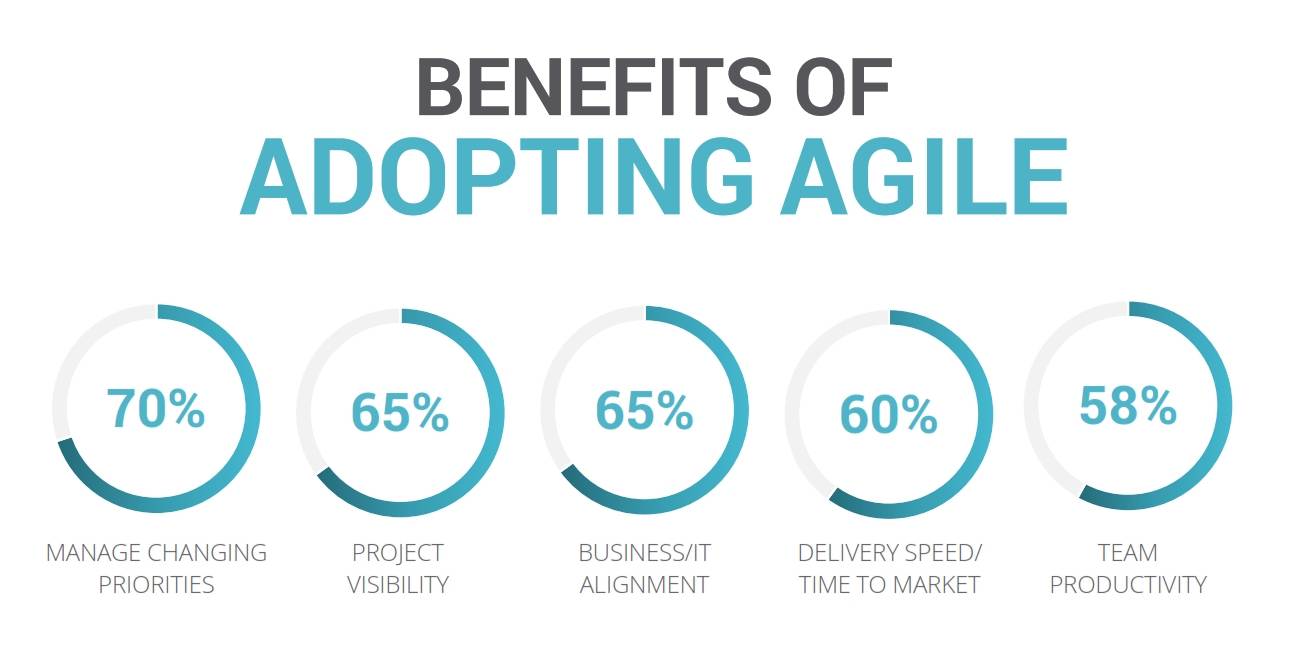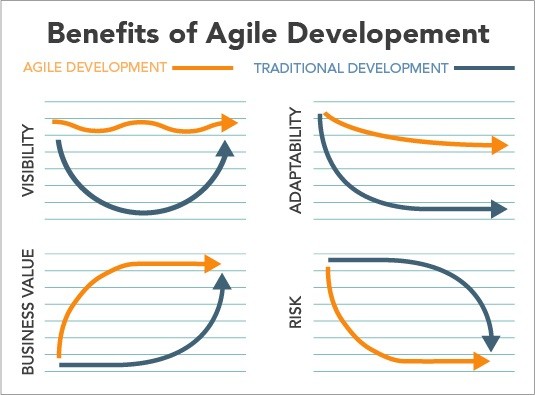9 Advantages of Agile Methodology and How To Reap Them Right
Children jump around, fall down, get back up, and hop and run all day. Adults avoid doing so to varying degrees, depending on how creaky the ageing bones are. However, with good lifestyle habits, adults can maintain childlike agility well into adult years. Just like the kids in the park, your business processes, too, can be agile. They can be built, tested, reworked, fine-tuned, and perfected in short cycles, using the advantages of Agile.
Why Does Agile Methodology Matter?
Imagine spending hours of effort and loads of money on projects that end up not matching the product requirement. Agile eliminates such possibilities. A project team adopting Agile methods would work on a portion of the project at one time, test the outcome, accept and assess feedbacks, and refine it further. They would do so while sticking to a strict timeline. The importance of Agile is also underlined by constant iteration. This ensures no task takes too long without being assessed. If backtracking is needed, less time and effort will be wasted. This is one prominent benefit of Agile development over conventional formal methods.

Source: DevCom
One of the benefits of Agile development over conventional methods is the scalability of Agile project management. By focusing on work priority and project status, Agile methods can be used to manage projects within an office or across a globally scattered project team.
9 Benefits of Agile Methodology That You Should Reap
Adapting Agile means that you can carry out and manage projects, or parts thereof, with more control. Its framework ensures that the project is carried out iteratively, with better handling of cost, schedule, risk, predictability, and quality. There are numerous advantages of Agile; here are nine that can be of practical use in your upcoming project.
1) Control Over the Project
Agile projects are continually assessed and tested, which gives a project manager more control. The managers use various reporting tools to get regular progress reports, which keep the project transparent. Quality control is assured strongly, and feedbacks are regularly integrated into the development of the product. The involvement of the stakeholders further adds to the quality control in project development and implementation phases. All these aspects combine to give the manager an outstanding advantage of Agile.
Exercise better control through the coordination of stakeholders, the product owner, and the development team. Make sure that planning, sprint reviews, and scrums are conducted as per the methods. Ensure adherence is maintained while defining roles, roadmaps, artifacts, and backlogs.
2) Improved Predictability
Due to their iterative nature, Agile projects are highly transparent in terms of progress and quality. For instance, Scrum is an Agile project management framework that uses product backlogs, sprint backlogs, burndown charts, etc. to assess the progress and weed out hindrances on an ongoing basis. Such a level of iteration ensures that there are no project surprises. Following these advantages of Agile improves the predictability of your projects.
To improve the predictability of your project, check the team alignment, their KPIs (key performance indicators), the work culture, etc. Then, identify project threats and obstacles and the best methods to tackle them. Seek innovation and continuous improvement in the project and keep it iterative. With clarity of milestones, data points and obstacles, project predictability improves.
3) Risk Management
By carrying out the project in small sprints, the size of risk attached is broken down into small parts. Consequently, the risk involved in a sprint is much more manageable. With continuous delivery at the forefront, any failure can be easily rectified even if things don’t go as planned. In this sense, the risk of Agile is better managed by avoiding that sinking feeling of realizing that an entire project has gone awry.
Risk identification is crucial to good risk management. This comes naturally as your involvement with the project increases. You have to assess project risks and consider your how best to respond. You may avoid or mitigate risks or accept them as a part of your project risk appetite. A risk burndown chart will help you identify the risk exposure and their impact. Regular review of risks is necessary for effective risk management.
4) Flexibility
The sprint-based working style also offers a lot of flexibility to Agile projects. Lasting a week or two, each sprint involves planning, development, stakeholder and product owner inputs, feedbacks, testing, quality assurance, and changes. Any change in feature or project direction is incorporated in sprint plans and project charters, making Agile projects highly flexible. Traditional methods, on the other hand, can be both expensive and time-consuming.

Source: Business 2 Community
Agile methods are inherently flexible, so adherence to these concepts is going to keep the project flexible. This includes sticking to small sprints, and stressing iterations and collaborations to keep refining the product.
5) Customer Satisfaction
Unlike traditional methods, Agile projects involve the customer during the development of the product. In traditional models, the customer is a part of the planning stage, followed by an anxious wait for the first unveiling of the finished product. In Agile, customer feedback is important in each sprint. Therefore, as the number of sprints increase, the quality of the finished product improves. By the time the product is market-ready, all customer inputs have been addressed. This gives Agile project outputs a better chance for customer satisfaction.
Involvement of the customer is obviously key to customer satisfaction. The project team should keep the product backlog updated at all times, identify and address priorities, and work on changes and new product features promptly.
6) Team Motivation
Agile project teams are a close group of co-workers from different functionalities and expertise. The flexible sprints provide greater authority to team members on product development. Collaboration and self-organizing are encouraged in Agile, which gives the project team more autonomy. Due to the nature of the working style, the team morale in Agile teams is bound to be higher than usual.
Lack of balanced workload can be one of the criticisms of Agile or any approach for that matter. Apart from a balanced workload, recognition of good work and allowing more say and stake in the development are important. The greater autonomy and self-resolution opportunities of Agile act as natural catalysts for better team motivation.
7) Continuous improvement
.jpg)
Source: Pinterest
Each sprint in Agile projects aims to identify mistakes and improvement points from the previous sprint and address them in the next one. With each sprint, the product is refined further. The spirit of collaboration and a problem-solving mentality ensures the product improves with each iteration. Agile promotes continual development through its framework. In fact, continuous improvement is one of the 12 core principles of the Agile Manifesto.
Retrospectives are seen as a fountainhead of continuous improvement in Agile projects. Assessing what worked and what didn’t in the sprint will help push for improvement with each sprint.
8) Better Product Quality
With ongoing iterations and motivation for continuous improvement, Agile projects end with a superior final product. This is the primary reason organizations across the world use Agile methods to manage projects and product development. Testing the product during each sprint ensures product quality is checked continually. The presence of the customer in the development phase further ensures that the product embodies all desired features.
Defining what is ‘done’ and not allowing underprepared work is important in maintaining quality. Inputs from stakeholders and cross-functional teams help improve the quality of the finished product, as does regular testing and prioritizing needed improvements.
9) Better Metrics
Metrics like velocity, lead-time, value delivered, and sprint burndown covers all aspects of product development in the Agile framework. Thus, another advantage of Agile over the Waterfall model, for instance, is Agile metrics. These metrics help the project team to measure team performance, identify roadblocks, and track time and cost estimations. With the help of these metrics, the Agile manager can make more data-driven decisions on matters related to the Agile project. Different methods come out of the Agile framework, such as Scrum, Kanban, and Scrumban, each of which tackle different requirement needs of an Agile approach.
Use a sprint burndown report to track completion and the epics and release burndowns to review the larger picture. The sprint velocity gives you a clear picture of individual sprints, while control charts monitor the cycle time of tasks from ‘in progress’ to ‘done’. These are some of the many key Agile metrics used to manage projects efficiently.
How Does a Certification Offer the Advantages of Agile?
Understanding Agile methods and concepts is achieved better with the help of relevant certification. If you look at a few of the objectives Agile methods seek to achieve, you will notice that it requires a thorough knowledge of the framework for a team member to work toward each objective.
Agile expects you to have a clear direction toward delivering value and helping the team perform better. With the help of Agile tools, concepts, and methods the project team can interact, collaborate, and coordinate more effectively.

Source: PlanView
Certifications themselves are not synonymous with success. Agile needs you to be open to constructive criticism, scrutinize mistakes, adapt, lead and manage teams, multi-task, translate customer needs to product features, and much more. However, a good Agile certification addresses many primary benefits of Agile.
The GreyCampus Agile Scrum Master Certification Training, for example, introduces you to Agile concepts, continual improvement of processes, the application of Agile principles to IT service management as well as key Agile activities, like estimation, planning, monitoring, and control. It also deconstructs complex project management skills, like ensuring scalability of Agile, Agile administration of tools, tool integration, and adaptability to different projects.
To Sum Up
It is beyond a doubt that the benefits of Agile can have a massive influence on the success of a project. The success of an IT practitioner in an Agile project team depends on their experience and understanding of Agile concepts and principles. While experience is gained over time, knowledge is something that can be obtained with a well-recognized certification. GreyCampus offers a Certified Scrum Master training and certification course as well as Agile Scrum Master Certification training. These are zero-level courses that can be taken without any prior knowledge or foundation of Agile methods. Imparted by real-life IT practitioners who share their industry and domain experience, these course programs accelerate your career development and help make you a successful Agile practitioner.
Want To Join the Global Pool of Agile Certified Practitioners? Sign Up for a Bootcamp Now!
